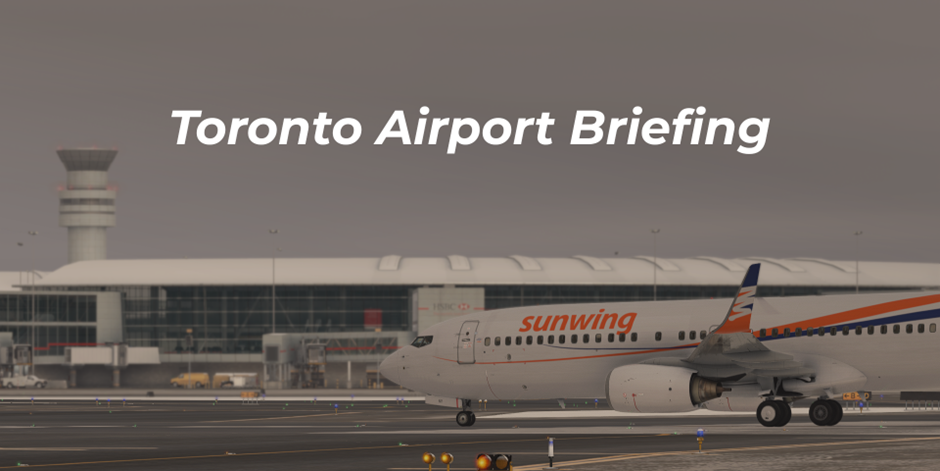¶ Toronto Airport
The information in this document is not intended for real aviation. It is only intended for computer-based flight simulation.

Toronto Pearson International Airport (CYYZ/YYZ) is the busiest airport in Canada. On our virtual airline you will come across this airport mainly as part of our seasonal lease operations.
This document summarizes essential information you should know for a realistic flight simulator experience.
For more information, please refer to the real-life Aeronautical Information Publication (AIP):
https://www.navcanada.ca/en/aeronautical-information/aip-canada.aspx
¶ Scenérie
Recommended CYYZ scenery for MSFS:
FlyTampa - payware
Recommended CYYZ scenery for X-Plane:
GloballArt - payware
chris.k - freeware
Recommended CYYZ scenery for Prepar3D:
FlyTampa - payware
Recommended CYYZ scenery for FSX:
FlyTampa - payware
Ray Smith - freeware
¶ Přílet
Due to noise abatement procedures, between 00:00 and 06:30 local time (05:00 to 11:30 UTC), landings are not permitted on runways 15R, 23, 24L, 24R, 33L and 33R, unless otherwise assigned by ATC.
During low visibility operations (“LVP”), only runways 05 and 06L are used for landing.
Aircraft must be established on the extended runway centerline at a minimum of 3000 feet AMSL, and no later than at the Final Approach Fix. This also applies to visual approaches.
Unless it is operationally necessary to use the entire runway, it is preferred that jet aircraft vacate the runways using the following taxiways:
| RWY | TWY |
|---|---|
| 05 | H3 |
| 06L | C3 |
| 06R | D3, D5 |
| 15L | B1, B3 |
| 15R | F1 |
| 23 | H2, H4 |
| 24L | D4, D8 |
| 24R | C2, C4 |
| 33L | F2, F4 |
| 33R | B2, B4 |
When flying online, after landing on 06R/24L, never cross the parallel runway 06L/24R without clearance.
If the weather at the aerodrome is poor, or if it is necessary to cross active runways during taxiing, Single Engine Taxi-In procedures should not be used.
At any time during the movement of an aircraft at Toronto Airport, the transponder must be on. The transponder should only be turned off after parking at the stand, when the engines are shut down.
¶ De-Icing
Given the weather conditions that prevail in Toronto during the winter, the de-icing system here is complex and sophisticated for maximum efficiency. Between Runways 33L and 33R, southeast of the centre of the airport, is the Central De-Icing Facility.
The Central De-Icing Facility consists of several pads, which are further divided into north, middle and south taxilanes. Aircraft with wingspan of up to 36 metres, which also includes the Boeing 737, can use all these taxilanes. However, no aircraft may cross the red lines, which mark the safe area for ground equipment parking. Aircraft enter from the east, facing west.
Some parts of the de-icing process are automated here in Toronto. For example, there are displays that assist the crew in stopping at their assigned position on the de-icing pad.
In the real world, in order to speed up the de-icing process, pilots are asked to have the aircraft in the correct configuration for de-icing when they arrive at the Central De-Icing Facility.
During the de-icing process, engine thrust must not be increased above ground idle.
Ice shedding from the engine blades is only allowed in designated areas (called IS - Ice Shed Area), located at selected taxiways. If the taxiway surface condition does not allow for a safe engine thrust increase for ice shedding, this procedure may be performed on the runway just prior to takeoff, after this is coordinated with ATC.
¶ Departure
At any time during the movement of an aircraft at Toronto Airport, the transponder must be on. The transponder should be switched on before the first aircraft movement. If no transponder code (squawk) is assigned by ATC, the pilot should set squawk 1000.
It is not permitted to use more engine thrust than the minimum needed breakaway thrust (“to get the aircraft moving”).
When departing from runway 23, intersection departure from taxiway H is normally used. Full runway length (and the use of taxiway Q), if necessary, must be specifically requested in the real world (and when flying online).
Due to noise abatement procedures, between 00:00 and 06:30 local time (05:00 to 11:30 UTC), take-offs from runways 05, 06L, 06R, 15L and 15R are not permitted, unless assigned otherwise by ATC.
The instrument departure procedure (SID) must be followed to a minimum altitude of 3600 feet AMSL. When departing from runways 33L and 33R, no deviation from the extended runway centerline is permitted until at least 4 miles from the airport.
During low visibility operations, only runways 05, 06L and 33R are used for take-off. In such cases, it is also not possible to use intersection departure from runway 06L.